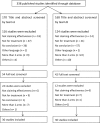Overstatements in abstract conclusions claiming effectiveness of interventions in psychiatry: A meta-epidemiological investigation
- PMID: 28902885
- PMCID: PMC5597227
- DOI: 10.1371/journal.pone.0184786
Overstatements in abstract conclusions claiming effectiveness of interventions in psychiatry: A meta-epidemiological investigation
Abstract
Objective: Abstracts of scientific reports are sometimes criticized for exaggerating significant results when compared to the corresponding full texts. Such abstracts can mislead the readers. We aimed to conduct a systematic review of overstatements in abstract conclusions in psychiatry trials.
Methods: We searched for randomized controlled trials published in 2014 that explicitly claimed effectiveness of any intervention for mental disorders in their abstract conclusion, using the Cochrane Register of Controlled Trials. Claims of effectiveness in abstract conclusion were categorized into three types: superiority (stating superiority of intervention to control), limited superiority (intervention has limited superiority), and equal efficactiveness (claiming equal effectiveness of intervention with standard treatment control), and full text results into three types: significant (all primary outcomes were statistically significant in favor of the intervention), mixed (primary outcomes included both significant and non-significant results), or all results non-significant. By comparing these classifications, we assessed whether each abstract was overstated. Our primary outcome was the proportion of overstated abstract conclusions.
Results: We identified and included 60 relevant trials. 20 out of 60 studies (33.3%) showed overstatements. Nine reports reported only significant results although none of their primary outcomes were significant. Large sample size (>300) and publication in high impact factor (IF>10) journals were associated with low occurrence of overstatements.
Conclusions: We found that one in three psychiatry studies claiming effectiveness in their abstract conclusion, either superior to control or equal to standard treatment, for any mental disorders were overstated in comparison with the full text results. Readers of the psychiatry literature are advised to scrutinize the full text results regardless of the claims in the abstract.
Trial registration: University hospital Medical Information Network (UMIN) Clinical Trials Registry (UMIN000018668).
Conflict of interest statement
Figures
Similar articles
-
Overstatements in abstract conclusions claiming effectiveness of interventions in psychiatry: a study protocol for a meta-epidemiological investigation.BMJ Open. 2016 Apr 21;6(4):e009832. doi: 10.1136/bmjopen-2015-009832. BMJ Open. 2016. PMID: 27103624 Free PMC article.
-
Does the CONSORT checklist for abstracts improve the quality of reports of randomized controlled trials on clinical pathways?J Eval Clin Pract. 2014 Dec;20(6):827-33. doi: 10.1111/jep.12200. Epub 2014 Jun 11. J Eval Clin Pract. 2014. PMID: 24916891
-
Influence of overstated abstract conclusions on clinicians: a web-based randomised controlled trial.BMJ Open. 2017 Dec 14;7(12):e018355. doi: 10.1136/bmjopen-2017-018355. BMJ Open. 2017. PMID: 29247102 Free PMC article. Clinical Trial.
-
The quality of reporting of trial abstracts is suboptimal: survey of major general medical journals.J Clin Epidemiol. 2009 Apr;62(4):387-92. doi: 10.1016/j.jclinepi.2008.05.013. Epub 2008 Nov 17. J Clin Epidemiol. 2009. PMID: 19010643 Review.
-
"Spin" in Plastic Surgery Randomized Controlled Trials with Statistically Nonsignificant Primary Outcomes: A Systematic Review.Plast Reconstr Surg. 2023 Mar 1;151(3):506e-519e. doi: 10.1097/PRS.0000000000009937. Epub 2022 Nov 29. Plast Reconstr Surg. 2023. PMID: 36442055
Cited by
-
Mapping the nomenclature, methodology, and reporting of studies that review methods: a pilot methodological review.Pilot Feasibility Stud. 2020 Jan 30;6:13. doi: 10.1186/s40814-019-0544-0. eCollection 2020. Pilot Feasibility Stud. 2020. PMID: 32699641 Free PMC article.
-
Scientific publications that use promotional language in the abstract receive more citations and public attention.Commun Psychol. 2025 Aug 5;3(1):118. doi: 10.1038/s44271-025-00293-8. Commun Psychol. 2025. PMID: 40764759 Free PMC article.
-
Physician characteristics associated with proper assessment of overstated conclusions in research abstracts: A secondary analysis of a randomized controlled trial.PLoS One. 2019 Jan 25;14(1):e0211206. doi: 10.1371/journal.pone.0211206. eCollection 2019. PLoS One. 2019. PMID: 30682128 Free PMC article.
-
Over-promotion and caution in abstracts of preprints during the COVID-19 crisis.Learn Publ. 2021 Jul 21;34(4):622-636. doi: 10.1002/leap.1411. Online ahead of print. Learn Publ. 2021. PMID: 34539096 Free PMC article.
-
Misreporting of Results of Research in Psychiatry.Schizophr Bull. 2021 Aug 21;47(5):1254-1260. doi: 10.1093/schbul/sbab040. Schizophr Bull. 2021. PMID: 33860793 Free PMC article.
References
-
- Burke DT, Judelson AL, Schneider JC, DeVito MC, Latta D. Reading habits of practicing physiatrists. Am J Phys Med Rehabil. 2002;81(10):779–87. Epub 2002/10/04. doi: 10.1097/01.PHM.0000027420.36815.3F . - DOI - PubMed
-
- Kurata K, Morioka T, Yokoi K, Matsubayashi M. Remarkable growth of open access in the biomedical field: analysis of PubMed articles from 2006 to 2010. PLoS One. 2013;8(5):e60925 Epub 2013/05/10. doi: 10.1371/journal.pone.0060925 ; PubMed Central PMCID: PMCPMC3641021. - DOI - PMC - PubMed
-
- Vinkers CH, Tijdink JK, Otte WM. Use of positive and negative words in scientific PubMed abstracts between 1974 and 2014: retrospective analysis. BMJ. 2015;351:h6467 Epub 2015/12/17. doi: 10.1136/bmj.h6467 ; PubMed Central PMCID: PMCPMC4677695. - DOI - PMC - PubMed
-
- Hopewell S, Clarke M, Moher D, Wager E, Middleton P, Altman DG, et al. CONSORT for reporting randomized controlled trials in journal and conference abstracts: explanation and elaboration. PLoS Med. 2008;5(1):e20 Epub 2008/01/25. doi: 10.1371/journal.pmed.0050020 ; PubMed Central PMCID: PMCPMC2211558. - DOI - PMC - PubMed
-
- Boutron I, Dutton S, Ravaud P, Altman DG. Reporting and interpretation of randomized controlled trials with statistically nonsignificant results for primary outcomes. JAMA. 2010;303(20):2058–64. Epub 2010/05/27. doi: 10.1001/jama.2010.651 . - DOI - PubMed
MeSH terms
LinkOut - more resources
Full Text Sources
Other Literature Sources
Medical
Miscellaneous





